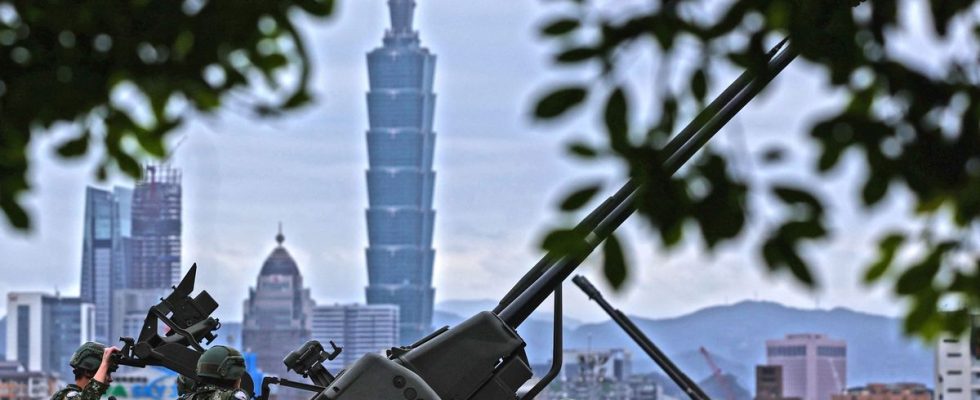No less than 12 warships and 91 planes on the last day of the operation, this Monday. These were the figures communicated by Taiwan, as China ended three days of military maneuvers in the region. Taiwan’s Foreign Ministry immediately accused Beijing of undermining “peace and stability”, also assuring that “the army will never relax its efforts to strengthen its combat readiness”. But what was the purpose of these maneuvers? Why did Washington and Japan add their two cents? And why would Beijing, backed by the Kremlin, threaten “peace and stability”? 20 minutes takes stock of the “Joint Sword” exercise, which is supposed to demonstrate “in depth the combat capacity” of China’s joint forces and which proves that the latter can, in three days, encircle Taiwan.
What happened this weekend in Taiwan?
The Chinese army announced on Monday that it had “successfully completed” the “Joint Sword” exercise, i.e. military maneuvers aimed at encircling the autonomous island of Taiwan for three days. From April 8 to 10, the Chinese military command “successfully completed various tasks” of military preparation “around the island of Taiwan, claimed by Beijing as a Chinese province”, the army said in a message broadcast on the social networks.
Fighter planes and warships simulated targeted bombardments against the island. And Taipei announced that 12 warships were detected as of 6 p.m. (local time) Monday around the island. For its part, the command of the Eastern theater of operations of the Chinese Army specified that the shandongone of China’s two aircraft carriers, had “participated in today’s exercise”.
In a video posted on the Army’s Eastern Theater Command WeChat account on Monday, a Chinese pilot said he “arrived near the northern part of the island of Taiwan” with missiles “locked in place”. In another video, set to dramatic music, an officer’s whistle causes military personnel to race into position as a mock barrage over Taiwan appears on screen.
Live-fire exercises were conducted in the Taiwan Strait near the coast of Fujian (east), the province facing the island, according to local Chinese maritime authorities.
Why did China launch these maneuvers?
The Chinese maneuvers, which began on Saturday, were aimed at protesting a meeting between Taiwanese President Tsai Ing-wen and the Speaker of the American House of Representatives, Kevin McCarthy. This meeting is to be held on Wednesday. The exercises “serve as serious warnings against collusion between separatist forces seeking ‘Taiwan independence’ and outside forces, as well as their provocative activities”, warned Chinese military spokesman Shi Yi. .
Beyond this diplomatic aspect, the objective was to simulate a “closure” of the territory of 23 million inhabitants claimed by Beijing, explained the Chinese army. And in particular an “air blockade”, according to state television CCTV. China has “extensively tested its joint” combat capability “in real conditions”, explained the Chinese military command, specifying today “to be ready for combat at any time and determined to crush any form of separatism for the independence of Taiwan and attempts at foreign interference”.
What are the reactions internationally?
These maneuvers received support from Russia on Monday. “China has the sovereign right to react (to) provocative actions” of the United States, “in particular by conducting maneuvers”, declared the spokesperson for the Russian presidency, Dmitry Peskov. As for the United States, they called for “restraint” while also seeming to want to make a show of force: the American destroyer USS Milius conducted a “freedom of navigation operation” on Monday in an area of the South China Sea claimed by Beijing. An “intrusion” immediately denounced by China. Japan has indicated that it has taken off fighter jets in recent days in response to those having taken off and landed from the aircraft carrier Shandong.
“The army will never relax its efforts to strengthen its combat readiness,” assured the Taiwanese Ministry of Defense. And after the maneuvers ended, Taiwan’s foreign ministry immediately accused China of undermining “peace and stability” in the region.
Why is the “peace” in the Taiwan region so fragile right now?
China views with displeasure the rapprochement in recent years between the Taiwanese authorities and the United States which, despite the absence of official relations, provides the island with substantial military support. It considers Taiwan as a province that it has not yet managed to reunify with the rest of its territory since the end of the Chinese civil war in 1949. Beijing is considering this reunification by force if necessary. As proof, the words spoken today by Wang Wenbin, spokesman of the Chinese Ministry of Foreign Affairs: “Taiwan independence and peace and stability in the Taiwan Strait are mutually exclusive. »
Recall the last major deployment around the island in August: China engaged in unprecedented military maneuvers around Taiwan and fired missiles in response to a visit to the island by Democrat Nancy Pelosi, then Speaker of the US House of Representatives. Since then, Beijing has been epidermal on the subject when Taiwan sends banderillas.
The fact remains that these new maneuvers have had reason to worry the population: “We ordinary people just want a simple and stable life,” says Lin Ke-qiang, a 60-year-old resident of Beigan Island in the Matsu archipelago. which belongs to Taiwan but is visible from the Chinese coast. If a war comes, now that their missiles are so advanced, we have no chance of resisting, we will be crushed. »

